Food Scarcity and Sustainable Solutions: A Comprehensive Examination
VerifiedAdded on 2022/09/06
|6
|967
|16
Homework Assignment
AI Summary
This assignment addresses the critical issue of food scarcity, particularly in the context of drought-stricken countries and a growing global population. The student explores the causes and effects of food shortages, referencing the '9 billion people' article and other research to highlight the urgency of the problem. The response analyzes potential solutions, including dietary shifts, reducing food waste, and investing in sustainable farming practices. The student evaluates the significance of the question, providing evidence of the impact of food scarcity on health, development, and societal stability, while also self-critiquing the question's depth, clarity, and supporting evidence. The assignment emphasizes the connection between food scarcity, climate change, and the need for comprehensive interventions to ensure global food security.
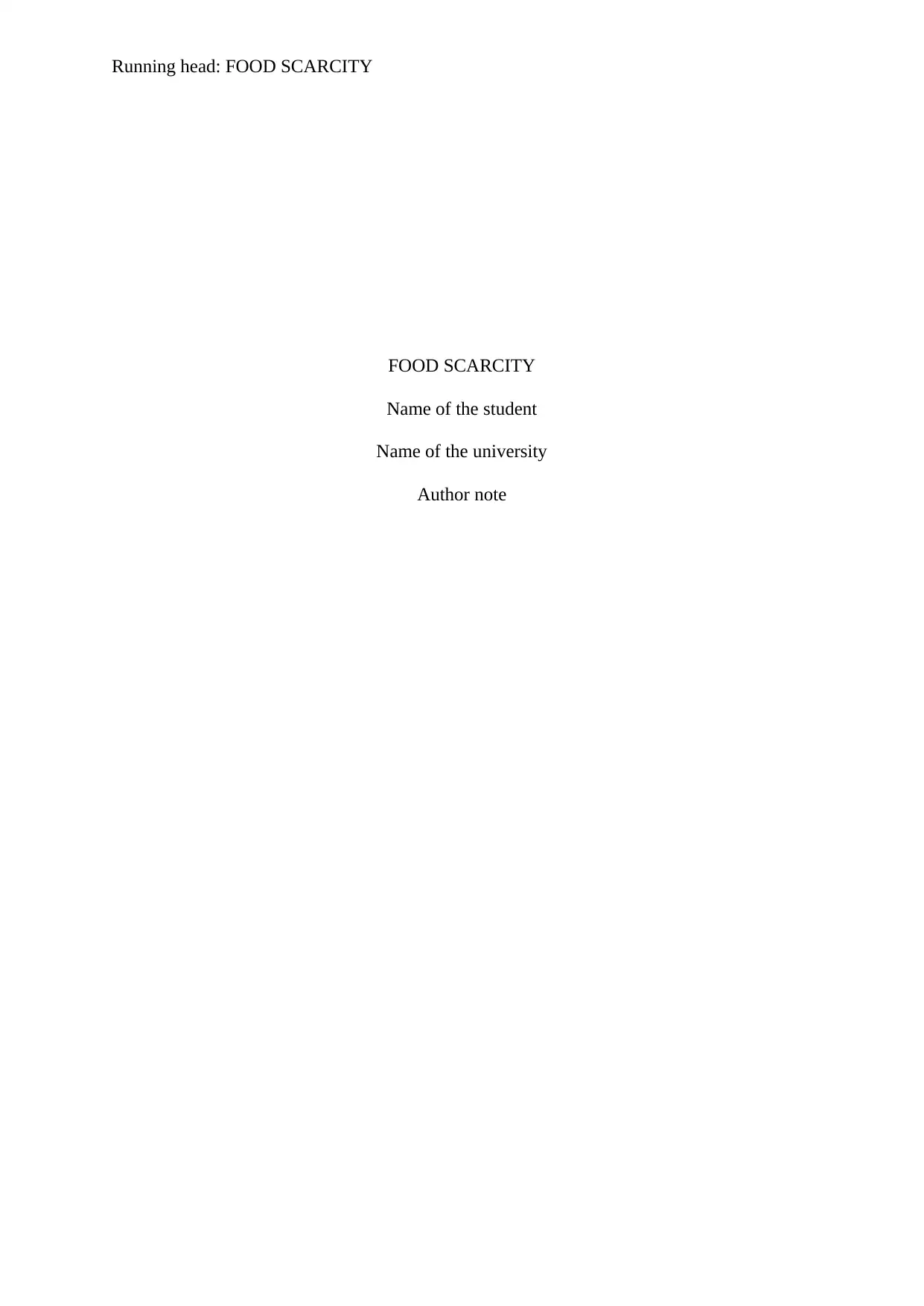
Running head: FOOD SCARCITY
FOOD SCARCITY
Name of the student
Name of the university
Author note
FOOD SCARCITY
Name of the student
Name of the university
Author note
Paraphrase This Document
Need a fresh take? Get an instant paraphrase of this document with our AI Paraphraser
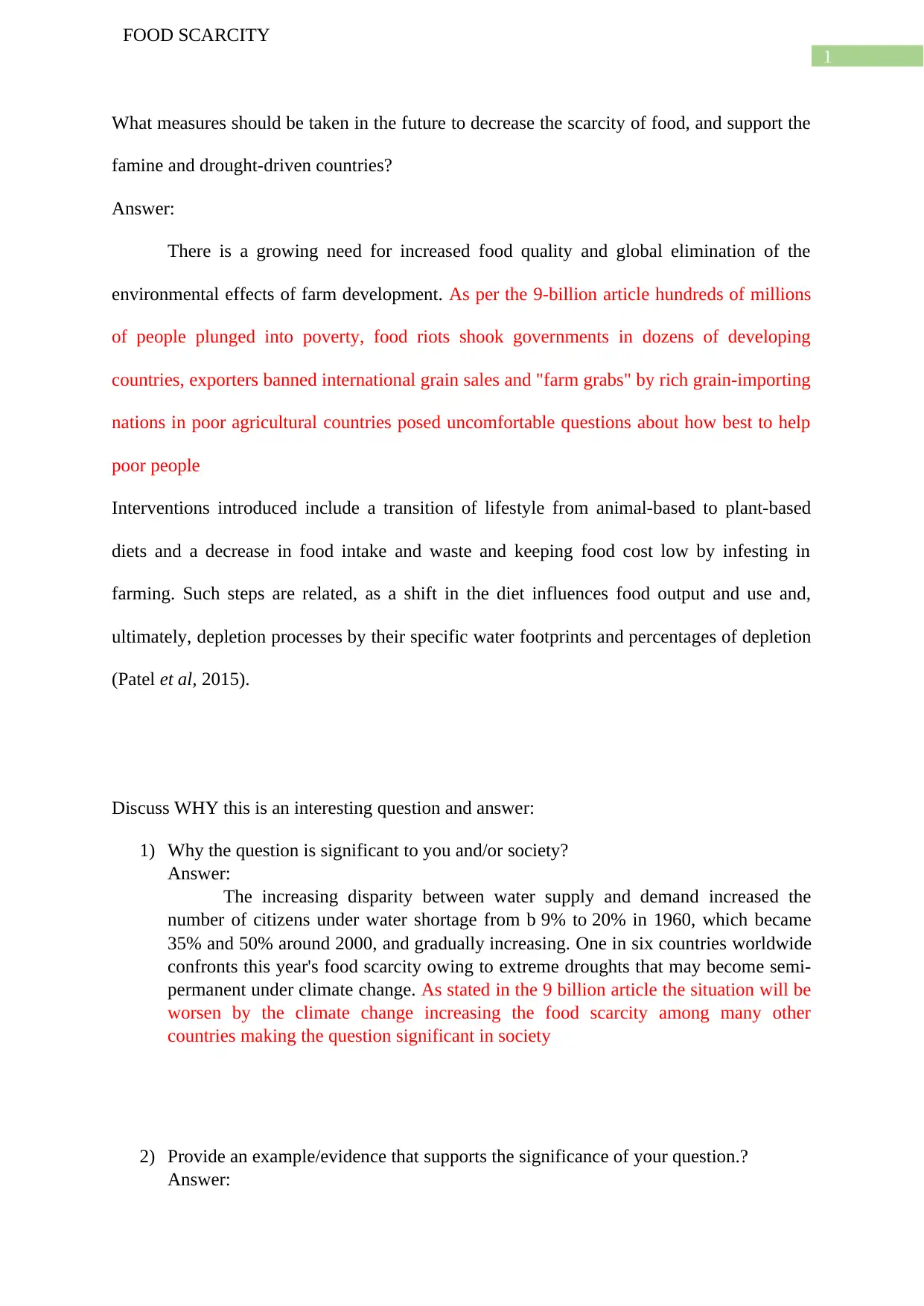
1
FOOD SCARCITY
What measures should be taken in the future to decrease the scarcity of food, and support the
famine and drought-driven countries?
Answer:
There is a growing need for increased food quality and global elimination of the
environmental effects of farm development. As per the 9-billion article hundreds of millions
of people plunged into poverty, food riots shook governments in dozens of developing
countries, exporters banned international grain sales and "farm grabs" by rich grain-importing
nations in poor agricultural countries posed uncomfortable questions about how best to help
poor people
Interventions introduced include a transition of lifestyle from animal-based to plant-based
diets and a decrease in food intake and waste and keeping food cost low by infesting in
farming. Such steps are related, as a shift in the diet influences food output and use and,
ultimately, depletion processes by their specific water footprints and percentages of depletion
(Patel et al, 2015).
Discuss WHY this is an interesting question and answer:
1) Why the question is significant to you and/or society?
Answer:
The increasing disparity between water supply and demand increased the
number of citizens under water shortage from b 9% to 20% in 1960, which became
35% and 50% around 2000, and gradually increasing. One in six countries worldwide
confronts this year's food scarcity owing to extreme droughts that may become semi-
permanent under climate change. As stated in the 9 billion article the situation will be
worsen by the climate change increasing the food scarcity among many other
countries making the question significant in society
2) Provide an example/evidence that supports the significance of your question.?
Answer:
FOOD SCARCITY
What measures should be taken in the future to decrease the scarcity of food, and support the
famine and drought-driven countries?
Answer:
There is a growing need for increased food quality and global elimination of the
environmental effects of farm development. As per the 9-billion article hundreds of millions
of people plunged into poverty, food riots shook governments in dozens of developing
countries, exporters banned international grain sales and "farm grabs" by rich grain-importing
nations in poor agricultural countries posed uncomfortable questions about how best to help
poor people
Interventions introduced include a transition of lifestyle from animal-based to plant-based
diets and a decrease in food intake and waste and keeping food cost low by infesting in
farming. Such steps are related, as a shift in the diet influences food output and use and,
ultimately, depletion processes by their specific water footprints and percentages of depletion
(Patel et al, 2015).
Discuss WHY this is an interesting question and answer:
1) Why the question is significant to you and/or society?
Answer:
The increasing disparity between water supply and demand increased the
number of citizens under water shortage from b 9% to 20% in 1960, which became
35% and 50% around 2000, and gradually increasing. One in six countries worldwide
confronts this year's food scarcity owing to extreme droughts that may become semi-
permanent under climate change. As stated in the 9 billion article the situation will be
worsen by the climate change increasing the food scarcity among many other
countries making the question significant in society
2) Provide an example/evidence that supports the significance of your question.?
Answer:
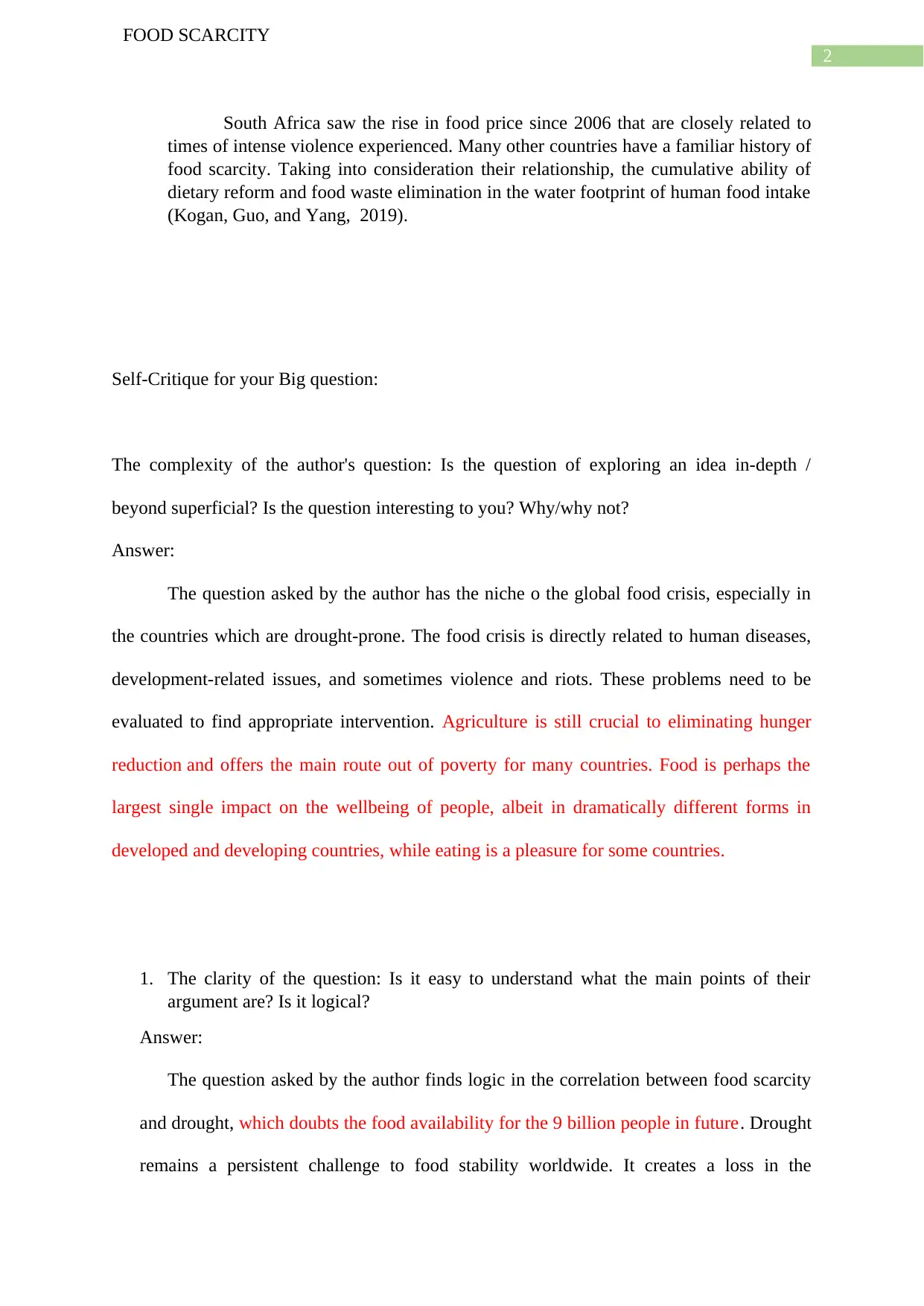
2
FOOD SCARCITY
South Africa saw the rise in food price since 2006 that are closely related to
times of intense violence experienced. Many other countries have a familiar history of
food scarcity. Taking into consideration their relationship, the cumulative ability of
dietary reform and food waste elimination in the water footprint of human food intake
(Kogan, Guo, and Yang, 2019).
Self-Critique for your Big question:
The complexity of the author's question: Is the question of exploring an idea in-depth /
beyond superficial? Is the question interesting to you? Why/why not?
Answer:
The question asked by the author has the niche o the global food crisis, especially in
the countries which are drought-prone. The food crisis is directly related to human diseases,
development-related issues, and sometimes violence and riots. These problems need to be
evaluated to find appropriate intervention. Agriculture is still crucial to eliminating hunger
reduction and offers the main route out of poverty for many countries. Food is perhaps the
largest single impact on the wellbeing of people, albeit in dramatically different forms in
developed and developing countries, while eating is a pleasure for some countries.
1. The clarity of the question: Is it easy to understand what the main points of their
argument are? Is it logical?
Answer:
The question asked by the author finds logic in the correlation between food scarcity
and drought, which doubts the food availability for the 9 billion people in future. Drought
remains a persistent challenge to food stability worldwide. It creates a loss in the
FOOD SCARCITY
South Africa saw the rise in food price since 2006 that are closely related to
times of intense violence experienced. Many other countries have a familiar history of
food scarcity. Taking into consideration their relationship, the cumulative ability of
dietary reform and food waste elimination in the water footprint of human food intake
(Kogan, Guo, and Yang, 2019).
Self-Critique for your Big question:
The complexity of the author's question: Is the question of exploring an idea in-depth /
beyond superficial? Is the question interesting to you? Why/why not?
Answer:
The question asked by the author has the niche o the global food crisis, especially in
the countries which are drought-prone. The food crisis is directly related to human diseases,
development-related issues, and sometimes violence and riots. These problems need to be
evaluated to find appropriate intervention. Agriculture is still crucial to eliminating hunger
reduction and offers the main route out of poverty for many countries. Food is perhaps the
largest single impact on the wellbeing of people, albeit in dramatically different forms in
developed and developing countries, while eating is a pleasure for some countries.
1. The clarity of the question: Is it easy to understand what the main points of their
argument are? Is it logical?
Answer:
The question asked by the author finds logic in the correlation between food scarcity
and drought, which doubts the food availability for the 9 billion people in future. Drought
remains a persistent challenge to food stability worldwide. It creates a loss in the
⊘ This is a preview!⊘
Do you want full access?
Subscribe today to unlock all pages.

Trusted by 1+ million students worldwide
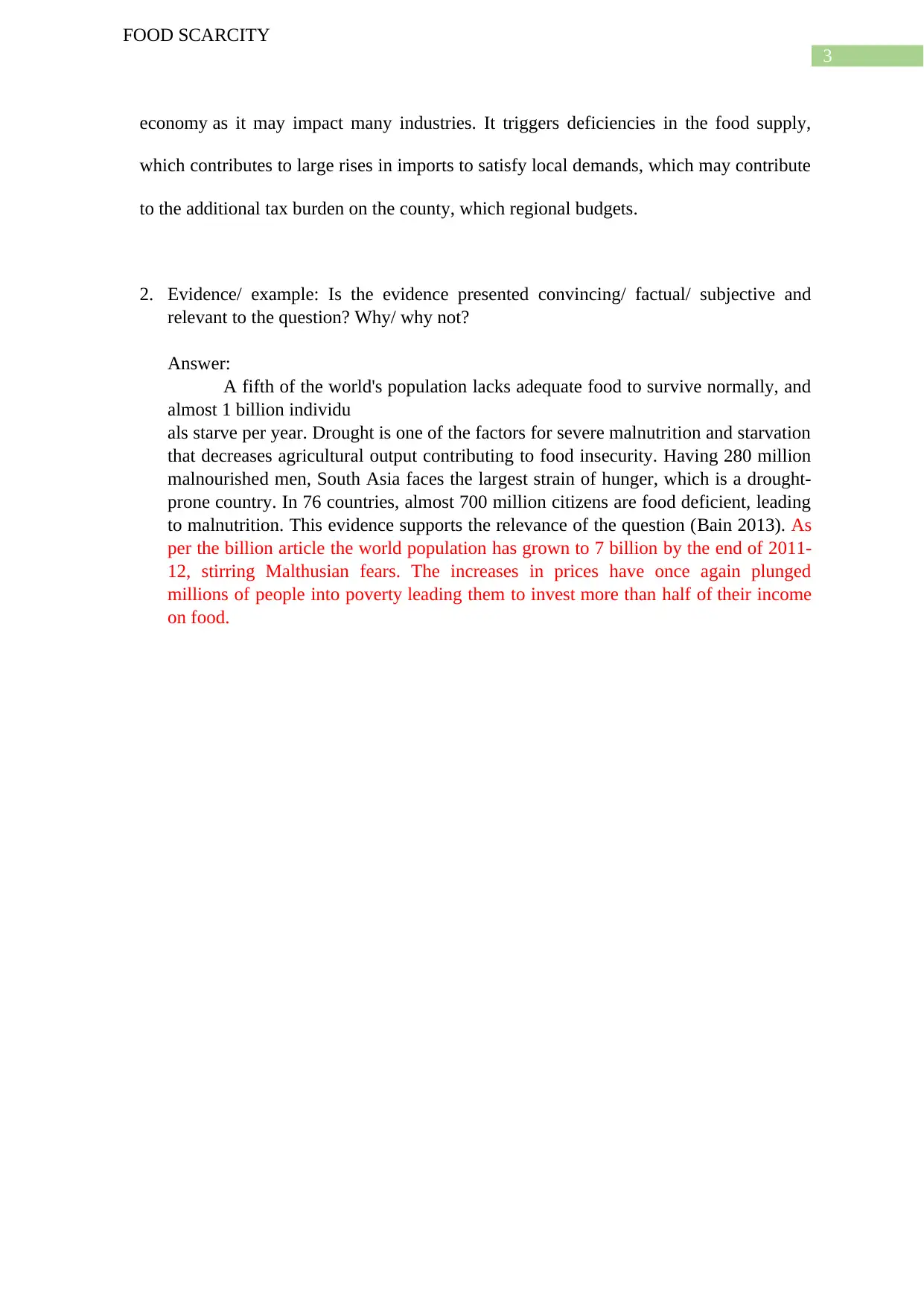
3
FOOD SCARCITY
economy as it may impact many industries. It triggers deficiencies in the food supply,
which contributes to large rises in imports to satisfy local demands, which may contribute
to the additional tax burden on the county, which regional budgets.
2. Evidence/ example: Is the evidence presented convincing/ factual/ subjective and
relevant to the question? Why/ why not?
Answer:
A fifth of the world's population lacks adequate food to survive normally, and
almost 1 billion individu
als starve per year. Drought is one of the factors for severe malnutrition and starvation
that decreases agricultural output contributing to food insecurity. Having 280 million
malnourished men, South Asia faces the largest strain of hunger, which is a drought-
prone country. In 76 countries, almost 700 million citizens are food deficient, leading
to malnutrition. This evidence supports the relevance of the question (Bain 2013). As
per the billion article the world population has grown to 7 billion by the end of 2011-
12, stirring Malthusian fears. The increases in prices have once again plunged
millions of people into poverty leading them to invest more than half of their income
on food.
FOOD SCARCITY
economy as it may impact many industries. It triggers deficiencies in the food supply,
which contributes to large rises in imports to satisfy local demands, which may contribute
to the additional tax burden on the county, which regional budgets.
2. Evidence/ example: Is the evidence presented convincing/ factual/ subjective and
relevant to the question? Why/ why not?
Answer:
A fifth of the world's population lacks adequate food to survive normally, and
almost 1 billion individu
als starve per year. Drought is one of the factors for severe malnutrition and starvation
that decreases agricultural output contributing to food insecurity. Having 280 million
malnourished men, South Asia faces the largest strain of hunger, which is a drought-
prone country. In 76 countries, almost 700 million citizens are food deficient, leading
to malnutrition. This evidence supports the relevance of the question (Bain 2013). As
per the billion article the world population has grown to 7 billion by the end of 2011-
12, stirring Malthusian fears. The increases in prices have once again plunged
millions of people into poverty leading them to invest more than half of their income
on food.
Paraphrase This Document
Need a fresh take? Get an instant paraphrase of this document with our AI Paraphraser
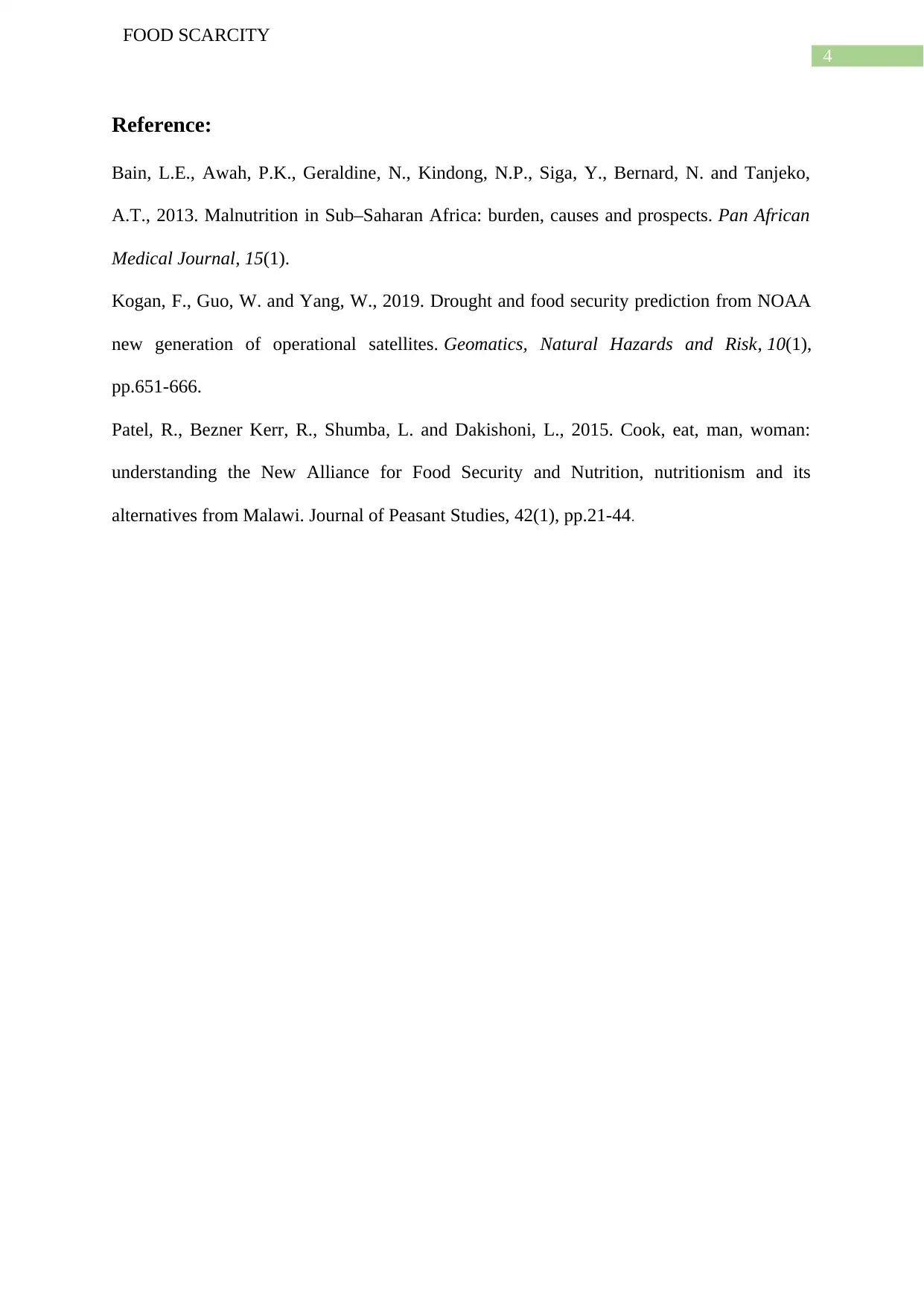
4
FOOD SCARCITY
Reference:
Bain, L.E., Awah, P.K., Geraldine, N., Kindong, N.P., Siga, Y., Bernard, N. and Tanjeko,
A.T., 2013. Malnutrition in Sub–Saharan Africa: burden, causes and prospects. Pan African
Medical Journal, 15(1).
Kogan, F., Guo, W. and Yang, W., 2019. Drought and food security prediction from NOAA
new generation of operational satellites. Geomatics, Natural Hazards and Risk, 10(1),
pp.651-666.
Patel, R., Bezner Kerr, R., Shumba, L. and Dakishoni, L., 2015. Cook, eat, man, woman:
understanding the New Alliance for Food Security and Nutrition, nutritionism and its
alternatives from Malawi. Journal of Peasant Studies, 42(1), pp.21-44.
FOOD SCARCITY
Reference:
Bain, L.E., Awah, P.K., Geraldine, N., Kindong, N.P., Siga, Y., Bernard, N. and Tanjeko,
A.T., 2013. Malnutrition in Sub–Saharan Africa: burden, causes and prospects. Pan African
Medical Journal, 15(1).
Kogan, F., Guo, W. and Yang, W., 2019. Drought and food security prediction from NOAA
new generation of operational satellites. Geomatics, Natural Hazards and Risk, 10(1),
pp.651-666.
Patel, R., Bezner Kerr, R., Shumba, L. and Dakishoni, L., 2015. Cook, eat, man, woman:
understanding the New Alliance for Food Security and Nutrition, nutritionism and its
alternatives from Malawi. Journal of Peasant Studies, 42(1), pp.21-44.
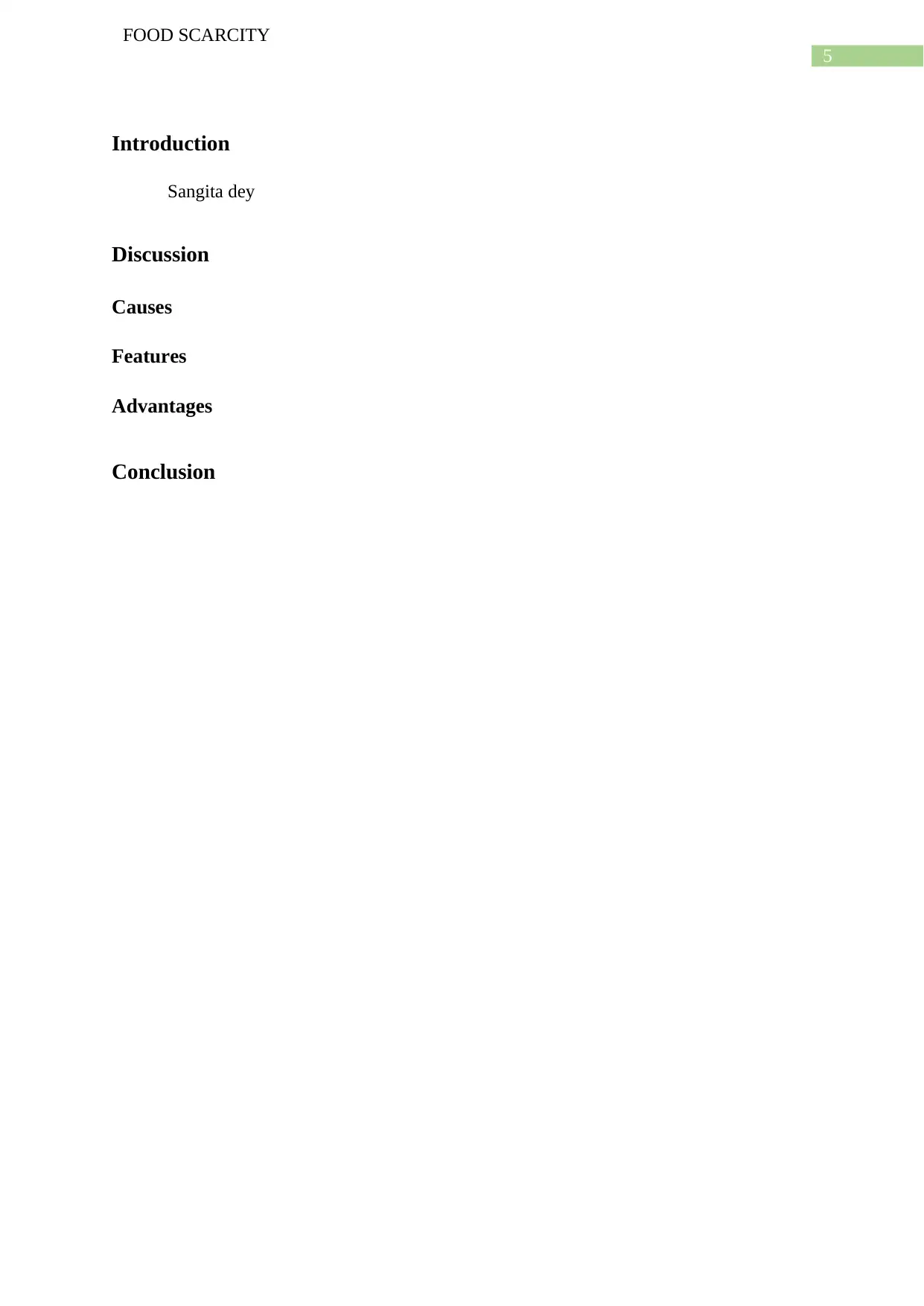
5
FOOD SCARCITY
Introduction
Sangita dey
Discussion
Causes
Features
Advantages
Conclusion
FOOD SCARCITY
Introduction
Sangita dey
Discussion
Causes
Features
Advantages
Conclusion
⊘ This is a preview!⊘
Do you want full access?
Subscribe today to unlock all pages.

Trusted by 1+ million students worldwide
1 out of 6
Your All-in-One AI-Powered Toolkit for Academic Success.
+13062052269
info@desklib.com
Available 24*7 on WhatsApp / Email
![[object Object]](/_next/static/media/star-bottom.7253800d.svg)
Unlock your academic potential
Copyright © 2020–2025 A2Z Services. All Rights Reserved. Developed and managed by ZUCOL.

